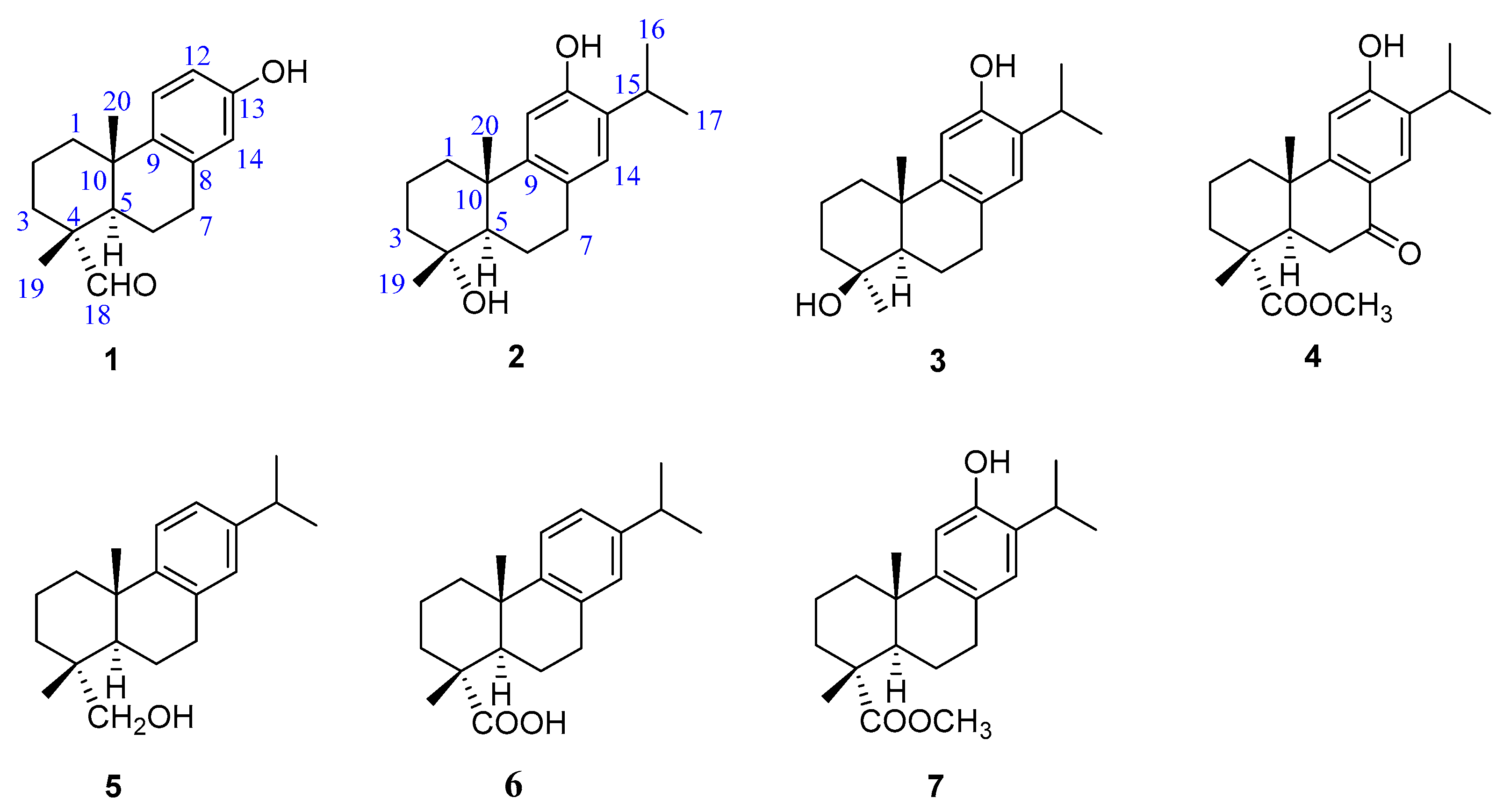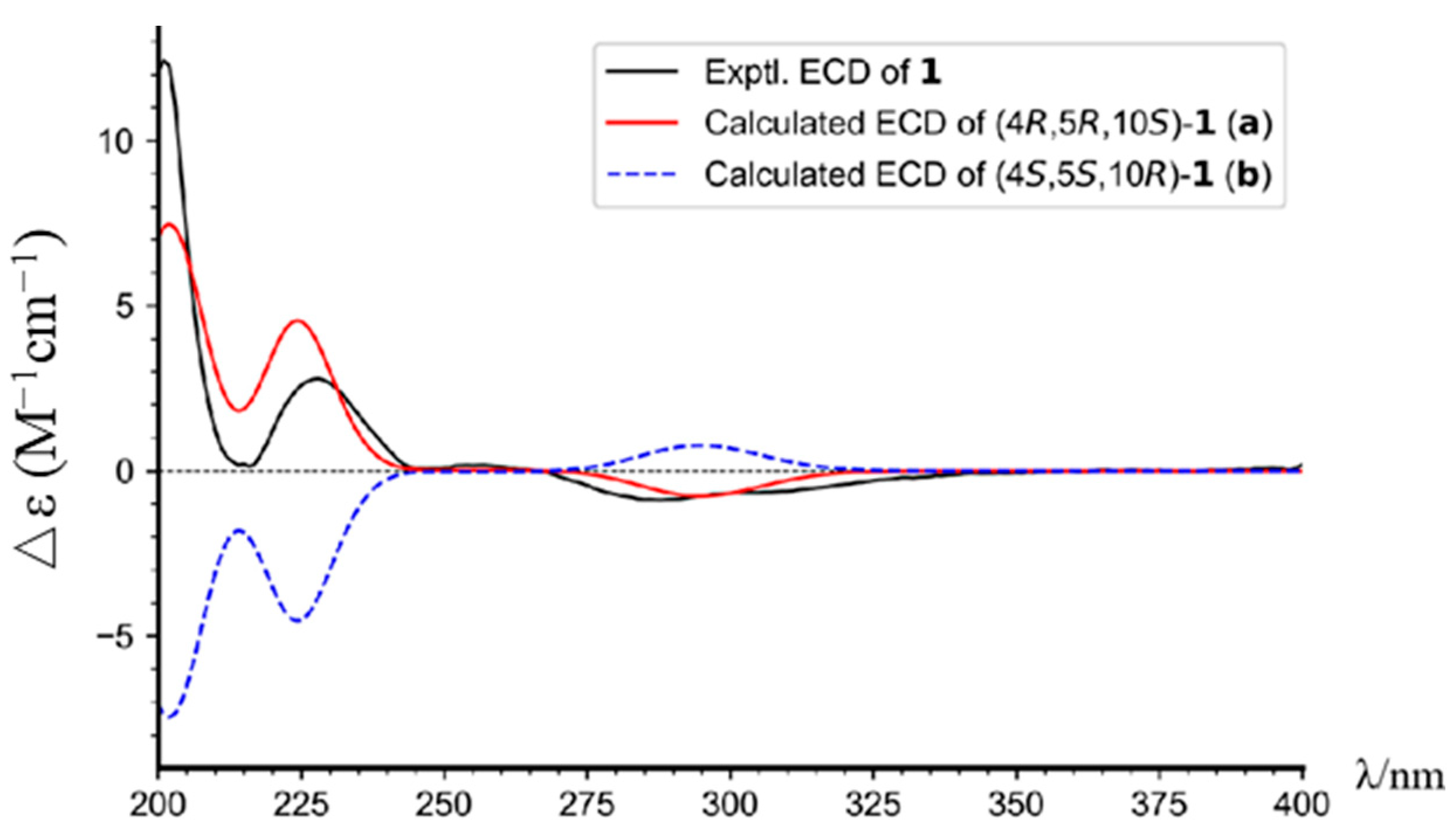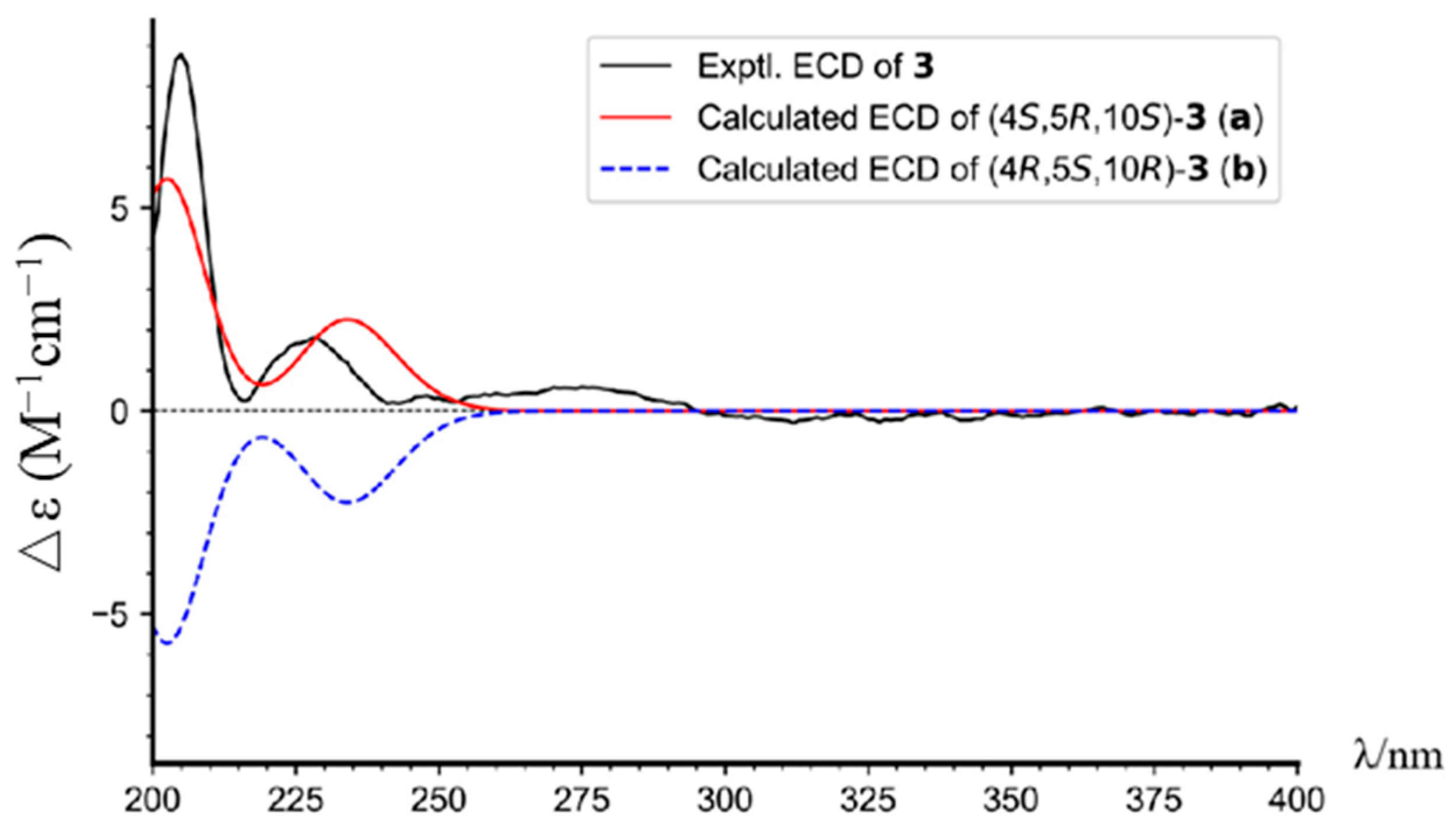Abietane-Type Diterpenoids from the Arils of Torreya grandis
Abstract
:1. Introduction
2. Results and Discussion
3. Materials and Methods
3.1. General
3.2. Plant Materials
3.3. Extraction and Isolation
3.4. Structural Elucidation
3.5. Crystal Data for Compounds 2 and 4
3.6. ECD Calculation
3.7. Antibacterial Assay
3.8. Cytotoxicity and Anti-Inflammatory Assays
4. Conclusions
Supplementary Materials
Author Contributions
Funding
Institutional Review Board Statement
Informed Consent Statement
Data Availability Statement
Acknowledgments
Conflicts of Interest
References
- Majeed, A.; Singh, A.; Choudhary, S.; Bhardwaj, P. RNAseq-based phylogenetic reconstruction of Taxaceae and Cephalotaxaceae. Cladistics 2019, 35, 461–468. [Google Scholar] [CrossRef]
- Zhou, W.; Harris, A.J.; Xiang, Q.Y. Phylogenomics and biogeography of Torreya (Taxaceae)—Integrating data from three organelle genomes, morphology, and fossils and a practical method for reducing missing data from RAD-seq. J. Syst. Evol. 2022, 60, 1241–1262. [Google Scholar] [CrossRef]
- Miao, Z.P.; Niu, X.N.; Wang, R.B.; Huang, L.; Ma, B.B.; Li, J.H.; Hong, X. Study of the genus Torreya (Taxaceae) based on chloroplast genomes. Front. Biosci. 2022, 27, 009. [Google Scholar] [CrossRef]
- Shi, L.K.; Mao, J.H.; Zheng, L.; Zhao, C.W.; Jin, Q.Z.; Wang, X.G. Chemical characterization and free radical scavenging capacity of oils obtained from Torreya grandis Fort. ex. Lindl. and Torreya grandis Fort. var. Merrillii: A comparative study using chemometrics. Ind. Crops Prod. 2018, 115, 250–260. [Google Scholar] [CrossRef]
- Song, L.; Meng, X.; Song, H.; Gao, L.; Gao, Y.; Chen, W.; Huan, W.; Suo, J.; Yu, W.; Wang, X.H.; et al. Bioactive ellagitannins and phenylpropanoid glycosides from the seed of Torreya grandis. Phytochem. Lett. 2023, 57, 172–176. [Google Scholar]
- Cui, J.J.; Li, W.J.; Wang, C.L.; Huang, Y.Q.; Lin, W.; Zhou, B.; Yue, J.M. Antimicrobial abietane-type diterpenoids from Torreya grandis. Phytochemistry 2022, 201, 113278. [Google Scholar] [CrossRef]
- Beatrice, G.; Francesco, G.; Virginia, L.; Domenico, M.; Raffaele, R.; Claudio, V.; He, G.F.; Ma, Z.W.; Yin, W.F. Grandione, a new heptacyclic dimeric diterpene from Torreya grandis Fort. Tetrahedron 1999, 55, 11385–11394. [Google Scholar]
- Saeed, M.K.; Khan, M.N.; Ahmad, I.; Hussain, N.; Ali, S.; Deng, Y.; Dai, R. Isolation, identification and antioxidant potential of major flavonoids from ethyl acetate fraction of Torreya grandis. Asian J. Chem. 2013, 25, 2459–2464. [Google Scholar] [CrossRef]
- Shi, H.; Wang, H.; Wang, M.; Li, X. Antioxidant activity and chemical composition of Torreya grandis cv. Merrillii seed. Nat. Prod. Commun. 2009, 4, 1565–1570. [Google Scholar] [CrossRef]
- He, Z.; Zhu, H.; Li, W.; Zeng, M.; Wu, S.; Chen, S.; Qin, F.; Chen, J. Chemical components of cold pressed kernel oils from different Torreya grandis cultivars. Food Chem. 2016, 209, 196–202. [Google Scholar] [CrossRef]
- Saeed, M.K.; Deng, Y.; Dai, R.; Li, W.; Yu, Y.; Iqbal, Z. Appraisal of antinociceptive and anti-inflammatory potential of extract and fractions from the leaves of Torreya grandis Fort Ex. Lindl. J. Ethnopharmacol. 2010, 127, 414–418. [Google Scholar] [CrossRef]
- Ma, J.; Yuan, T.; Gao, Y.; Zeng, X.; Liu, Z.; Gao, J. Torreya grandis oil attenuates cognitive impairment in scopolamine-induced mice. Food Funct. 2023, 14, 10520–10534. [Google Scholar] [CrossRef]
- Yu, Y.J.; Ni, S.; Wu, F.; Sang, W.G. Chemical composition and antioxidant activity of essential oil from Torreya grandis cv. merrillii Arils. J. Essent. Oil Bear. Plants 2016, 19, 1170–1180. [Google Scholar] [CrossRef]
- Zhou, D.Z.; Yi, Y.H.; Mao, S.L.; Lu, T.S.; Tang, H.F.; Zou, Z.R.; Zhang, S.Y. The lignins from Torreya grandis cv. Merrilli. Acta Pharm. Sin. 2004, 39, 269–271. [Google Scholar]
- Tang, J.J.; Huang, L.F.; Deng, J.L.; Wang, Y.M.; Guo, C.; Peng, X.N.; Liu, Z.; Gao, J.M. Cognitive enhancement and neuroprotective effects of OABL, a sesquiterpene lactone in 5xFAD Alzheimer’s disease mice model. Redox Biol. 2022, 50, 102229. [Google Scholar] [CrossRef]
- Xie, J.Y.; Wang, Z.X.; Liu, W.Y.; Liu, H.W.; Li, D.; Sang, Y.F.; Yang, Z.; Gao, J.M.; Yan, X.T. Hyperelatolides A–D, antineuroinflammatory constituents with unusual carbon skeletons from Hypericum elatoides. J. Nat. Prod. 2023, 86, 1910–1918. [Google Scholar] [CrossRef]
- Xie, J.Y.; Li, P.; Yan, X.T.; Gao, J.M. Discovery from Hypericum elatoides and synthesis of hyperelanitriles as α-aminopropionitrile-containing polycyclic polyprenylated acylphloroglucinols. Commun. Chem. 2024, 7, 1. [Google Scholar] [CrossRef]
- Cheung, H.T.; Miyase, T.; Lenguyen, M.P.; Smal, M.A. Further acidic constituents and neutral components of Pinus massoniana Resin. Tetrahedron 1993, 49, 7903–7915. [Google Scholar] [CrossRef]
- Harrison, L.J.; Asakawa, Y. 18-Oxoferruginol from the leaf of Torreya nucifera. Phytochemistry 1987, 26, 1211–1212. [Google Scholar] [CrossRef]
- Yang, Z.; Luo, W.; Yang, Z.; Zhang, M.; Dong, M.; Guo, D.; Gu, J.; Sun, C.; Xiao, S. Diterpenoids from Torreya grandis and their cytotoxic activities. Phytochemistry 2024, 221, 114036. [Google Scholar] [CrossRef]
- Yang, X.W.; Li, S.M.; Feng, L.; Shen, Y.H.; Tian, J.M.; Liu, X.H.; Zeng, H.W.; Zhang, C.; Zhang, W.D. Abiesanordines A–N: Fourteen new norditerpenes from Abies georgei. Tetrahedron 2008, 64, 4354–4362. [Google Scholar] [CrossRef]
- Hamulić, D.; Stadler, M.; Hering, S.; Padrón, J.M.; Bassett, R.; Rivas, F.; Loza-Mejía, M.A.; Dea-Ayuela, M.A.; González-Cardenete, M.A. Synthesis and biological studies of (+)-liquiditerpenoic acid A (abietopinoic acid) and representative analogues: SAR studies. J. Nat. Prod. 2019, 82, 823–831. [Google Scholar] [CrossRef]
- Fraga, B.M.; Hernández, M.G.; Artega, J.M.; Suárez, S. The microbiological transformation of the diterpenes dehydroabietanol and teideadiol by Mucor plumbeus. Phytochemistry 2003, 63, 663–668. [Google Scholar] [CrossRef]
- van Beek, T.A.; Claassen, F.W.; Dorado, J.; Godejohann, M.; Sierra-Alvarez, R.; Wijnberg, J.B. Fungal biotransformation products of dehydroabietic acid. J. Nat. Prod. 2007, 70, 154–159. [Google Scholar] [CrossRef]
- He, G.; Ma, Z.; Yin, W. A new diterpenoid component torreyagrandate from leaves of Torreya grandis Fort. endemic in China. Acta Bot. Sin. 1985, 27, 300–303. [Google Scholar]
- Zhai, L.L.; Jiang, T.T.; Zhang, R.; Li, J.N.; Zhai, Y.J.; Zhang, Q.; Li, D.; Han, W.B. Ergostane-type sterols and sesquiterpenes with anti-neuroinflammatory activity from a Nigrograna species associated with Clematis shensiensis. Phytochemistry 2023, 211, 113690. [Google Scholar] [CrossRef]
- Tang, D.; Liu, L.L.; He, Q.R.; Yan, W.; Li, D.; Gao, J.M. Ansamycins with antiproliferative and antineuroinflammatory activity from moss-soil-derived Streptomyces cacaoi subsp. asoensis H2S5. J. Nat. Prod. 2018, 81, 1984–1991. [Google Scholar] [CrossRef]
- Han, W.B.; Wang, G.Y.; Tang, J.J.; Wang, W.J.; Liu, H.; Gil, R.R.; Navarro-Vázquez, A.; Lei, X.; Gao, J.M. Herpotrichones A and B, two Intermolecular [4 + 2] adducts with anti-neuroinflammatory activity from a Herpotrichia Species. Org. Lett. 2020, 22, 405–409. [Google Scholar] [CrossRef]







| No. | 1 a | 2 b | ||
|---|---|---|---|---|
| δC Type | δH (J in Hz) | δC Type | δH (J in Hz) | |
| 1 | 38.1 | 2.24 (m, 1H); 1.77 (m, 1H) | 39.5 | 2.19 (m, 1H); 1.36 (m, 1H) |
| 2 | 17.8 | 1.71 (m, 2H) | 21.5 | 1.70 (m, 1H); 1.66 (m, 1H) |
| 3 | 32.2 | 1.40 (m, 1H); 1.27 (m, 1H) | 43.4 | 1.80 (m, 1H); 1.43 (m, 1H) |
| 4 | 49.9 | 73.2 | ||
| 5 | 43.0 | 1.79 (m, 1H) | 53.4 | 1.55–1.58 (m, 1H) |
| 6 | 21.4 | 1.75 (m, 1H); 1.26(m, 1H) | 19.3 | 2.09 (m, 1H); 1.58–1.67 (m, 1H) |
| 7 | 29.8 | 2.69 (m, 2H) | 30.8 | 2.78 (m, 2H) |
| 8 | 136.5 | 126.8 | ||
| 9 | 141.5 | 148.3 | ||
| 10 | 36.2 | 39.3 | ||
| 11 | 125.7 | 7.05 (d, 8.6, 1H) | 111.8 | 6.63 (s, 1H) |
| 12 | 113.3 | 6.56 (dd, 8.6, 3.0, 1H) | 153.4 | |
| 13 | 153.4 | 133.5 | ||
| 14 | 115.2 | 6.43 (d, 3.0, 1H) | 127.4 | 6.75 (s, 1H) |
| 15 | 27.7 | 3.17 (m, 1H) | ||
| 16 | 23.2 | 1.16 (d, 7.0, 3H) | ||
| 17 | 23.2 | 1.17 (d, 7.0, 3H) | ||
| 18 | 206.6 | 9.20 (s, 1H) | ||
| 19 | 14.1 | 1.09 (s, 3H) | 22.9 | 1.19 (s, 3H) |
| 20 | 25.4 | 1.13 (s, 3H) | 24.9 | 1.13 (s, 3H) |
| 18-OMe | ||||
| No. | 3 a | 4 b | ||
|---|---|---|---|---|
| δC Type | δH (J in Hz) | δC Type | δH (J in Hz) | |
| 1 | 38.4 | 2.21 (dt, 13.0, 4.0, 1H); 1.42 (m, 1H) | 36.7 | 2.17 (dd, 12.9, 3.5, 1H); 1.60–1.72 (m, 1H) |
| 2 | 18.6 | 1.62 (m, 2H) | 17.7 | 1.60–1.72 (m, 1H); 1.48 (td, 12.9, 3.8, 1H) |
| 3 | 40.9 | 1.72 (m, 1H); 1.42 (m, 1H) | 36.1 | 1.76 (t, 12.9, 1H); 1.60–1.72 (m, 1H) |
| 4 | 72.5 | 46.2 | ||
| 5 | 48.8 | 1.42 (m, 1H) | 44.0 | 2.45 (dd, 14.1, 3.3, 1H) |
| 6 | 18.2 | 2.00 (m, 1H); 1.83 (m, 1H) | 37.2 | 2.68 (dd, 17.6, 14.1, 1H); 1.98 (dd, 17.6, 3.3, 1H) |
| 7 | 28.8 | 2.86 (m, 2H) | 195.6 | |
| 8 | 127.1 | 122.3 | ||
| 9 | 147.9 | 2.3 (m, 1H) | 155.3 | |
| 10 | 37.3 | 37.0 | ||
| 11 | 110.9 | 6.64 (s, 1H) | 109.3 | 6.79 (s, 1H) |
| 12 | 150.9 | 160.5 | ||
| 13 | 131.7 | 132.9 | ||
| 14 | 126.8 | 6.85 (s, 1H) | 125.1 | 7.64 (s, 1H) |
| 15 | 27.0 | 3.12 (m, 1H) | 26.1 | 3.13 (m, 1H) |
| 16 | 22.7 | 1.23 (d, 7.0, 3H) | 22.2 | 1.13 (d, 6.4, 3H) |
| 17 | 22.9 | 1.24 (d, 7.0, 3H) | 22.4 | 1.14 (d, 6.4, 3H) |
| 18 | 30.9 | 1.25 (s, 3H) | 177.3 | |
| 19 | 16.2 | 1.25 (s, 3H) | ||
| 20 | 24.5 | 1.30 (s, 3H) | 23.2 | 1.18 (s, 3H) |
| 18-OMe | 52.3 | 3.59 (s, 3H) | ||
| Compound | IC50 (μM) a | Cell Viability (%) b |
|---|---|---|
| 1 | 49.4 ± 0.4 | 81.6 ± 3.5 |
| 3 | 41.9 ± 1.5 | 85.4 ± 1.3 |
| 4 | 38.4 ± 0.6 | 87.1 ± 2.3 |
| 7 | 52.6 ± 2.3 | 96.1 ± 1.0 |
| quercetin c | 10.8 ± 1.6 | 99.7 ± 1.8 |
Disclaimer/Publisher’s Note: The statements, opinions and data contained in all publications are solely those of the individual author(s) and contributor(s) and not of MDPI and/or the editor(s). MDPI and/or the editor(s) disclaim responsibility for any injury to people or property resulting from any ideas, methods, instructions or products referred to in the content. |
© 2024 by the authors. Licensee MDPI, Basel, Switzerland. This article is an open access article distributed under the terms and conditions of the Creative Commons Attribution (CC BY) license (https://creativecommons.org/licenses/by/4.0/).
Share and Cite
Gao, Y.; Yang, J.; Zhang, Y.; Gao, L.; Tian, J.; Han, W.; Gao, J. Abietane-Type Diterpenoids from the Arils of Torreya grandis. Molecules 2024, 29, 1905. https://doi.org/10.3390/molecules29091905
Gao Y, Yang J, Zhang Y, Gao L, Tian J, Han W, Gao J. Abietane-Type Diterpenoids from the Arils of Torreya grandis. Molecules. 2024; 29(9):1905. https://doi.org/10.3390/molecules29091905
Chicago/Turabian StyleGao, Yuqi, Jinghui Yang, Yue Zhang, Linlin Gao, Junmian Tian, Wenbo Han, and Jinming Gao. 2024. "Abietane-Type Diterpenoids from the Arils of Torreya grandis" Molecules 29, no. 9: 1905. https://doi.org/10.3390/molecules29091905





